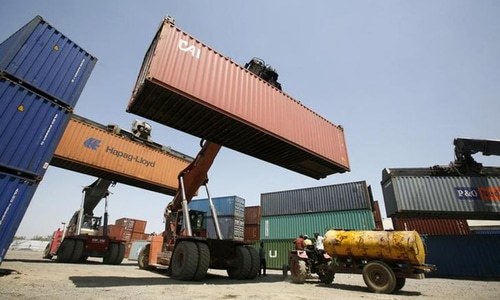ISLAMABAD: Pakistan’s exports grew for the second consecutive month in October to $2.066 billion, up 2.1 per cent from $2.024bn in the corresponding period last year, data released by the Ministry of Commerce showed on Tuesday.
Exports in the new fiscal year started on a positive note but witnessed steep decline of 19pc in August before rebounding in September and October.
Between July to October, exports fell by 0.1pc to $7.540bn, from $7.547bn over the corresponding months of last year.
In FY20, exports fell by 6.83pc or $1.57bn to $21.4bn, compared to $22.97bn the previous year. Data shows visible improvements in export orders from international buyers, mainly in the textile and clothing sectors since May.
Adviser to PM on Commerce Razak Dawood expressed his satisfaction at the export trends and praised Pakistan’s exporters, who made it possible for bringing the exports to pre-Covid-19 levels despite uncertainty and contraction in Pakistan’s major export markets.
In a statement, Dawood expressed his hope that Pakistan’s economy will continue on its upward recovery trend and directed officials to continue facilitating exporters and businessmen.
On the other hand, imports posted a negative growth of 10.3pc in October to $3.653bn, as against $4.074bn over the corresponding month of last year. During 4MFY20, the overall import bill dropped by 2.02pc to $14.964bn, down from $15.273bn over the corresponding months of last year.
The continuous decline in imports has provided some breathing space to the government in managing external accounts despite a downward trend in exports. However, imports are now expected to increase in the coming months following the abolishment of regulatory duty on imports of raw materials and semi-finished products.
In FY20, the import bill witnessed a steep decline of $10.29bn or 18.78pc to $44.509bn, compared to $54.799bn in the previous year.
The country’s trade deficit also shrank by 22.6pc in October, mainly due to a growth in export proceeds. In absolute terms, the trade gap narrowed to $1.587bn, as compared to $2.05bn over the corresponding month of last year.
In the first four months, the trade deficit narrowed by 4.5pc to $7.424bn, as against $7.776bn over the last year. During FY20, it narrowed to $23.099bn, from $31.820bn.
An official announcement of the ministry further said the rise in export was due to value-added sectors. The increases were witnessed in home textiles, up 10.0pc; women’s garments 20.8pc; jerseys & pullovers 35.3pc; made-up articles of textile 10.4pc; stockings & socks 19.2pc; cement 10.8pc; pharmaceutical products 26.8pc; tarpaulins 66.8pc and made-up clothing accessories 245.2pc as compared to the same period last year.
A decline was noted in non-value added sectors during the period under review. In the non-value-added sectors, exports of cotton fabric declined by 8.0pc; cotton yarn 40.1pc; worn clothing 63.6pc; raw leather 38.4pc; crude petroleum 53.7pc and cotton 95.7pc.
Pakistan’s top five growing export markets during July-October were: Indonesia, witnessing a growth of 39.3pc, followed by Qatar 34.5pc, Denmark 24.9pc, South Korea 22.5pc and Afghanistan 15.6pc.








